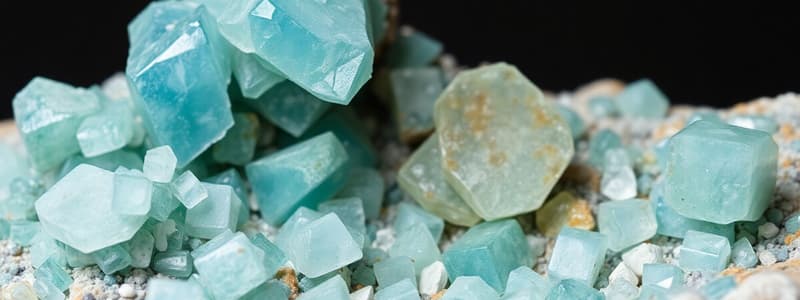Podcast
Questions and Answers
Match the following minerals with their common uses:
Match the following minerals with their common uses:
Quartz = Used in glass making Calcite = Used in cement production Gypsum = Used in drywall Mica = Used in electrical insulators
Match the following minerals with their chemical formulas:
Match the following minerals with their chemical formulas:
Halite = NaCl Gypsum = CaSO4·2H2O Fluorite = CaF2 Calcite = CaCO3
Match the following minerals with their class:
Match the following minerals with their class:
Quartz = Silicate Limestone = Carbonate Mica = Silicate Hematite = Oxide
Match the following minerals with their sources:
Match the following minerals with their sources:
Match the following minerals with their hardness on the Mohs scale:
Match the following minerals with their hardness on the Mohs scale:
Flashcards
nonrenewable resources
nonrenewable resources
resource that takes millions of years to form
Cleavage
Cleavage
splitting of certain minerals
Fracture
Fracture
a mineral naturally break’s unevenly
Streak
Streak
Signup and view all the flashcards
Hardness
Hardness
Signup and view all the flashcards
Renewable resources
Renewable resources
Signup and view all the flashcards
pollution
pollution
Signup and view all the flashcards
ore
ore
Signup and view all the flashcards
fossil fuels
fossil fuels
Signup and view all the flashcards
matter
matter
Signup and view all the flashcards
element
element
Signup and view all the flashcards
compound
compound
Signup and view all the flashcards
ionic bond
ionic bond
Signup and view all the flashcards
covalent bond
covalent bond
Signup and view all the flashcards
mineral
mineral
Signup and view all the flashcards
magma
magma
Signup and view all the flashcards
silicate
silicate
Signup and view all the flashcards
Gems
Gems
Signup and view all the flashcards
Moh’s (hardness scale)
Moh’s (hardness scale)
Signup and view all the flashcards
color
color
Signup and view all the flashcards
Study Notes
Definition and Characteristics
- Minerals are naturally occurring inorganic solids with a definite chemical composition and ordered atomic arrangement.
- They are formed through geological processes, not biological ones.
- Minerals are the building blocks of rocks.
- They exhibit specific physical properties, including crystal structure, hardness, cleavage, and luster, that are diagnostic for identification.
- These properties are largely determined by the chemical bonding within the mineral.
Formation of Minerals
- Minerals form from various processes, including:
- Crystallization from magma (e.g., igneous rocks)
- Precipitation from solutions (e.g., evaporites like halite)
- Metamorphism of existing rocks (e.g., minerals in metamorphic rocks)
- Biological processes (e.g., some carbonate minerals)
- The specific environment and conditions greatly influence the mineral formed and its characteristics.
- Temperature, pressure, and the presence of other elements in solution play a key role in mineral formation.
Crystal Structure and Bonding
- Minerals have a specific, repeating atomic arrangement called a crystal structure.
- This structure results from the way atoms bond together, creating patterns that can be observed in macroscopic crystals.
- Common types of chemical bonding in minerals include ionic, covalent, and metallic bonds.
- The type of bonding influences the strength, hardness, and other properties of the mineral.
- The crystal lattice affects the way light interacts with the mineral, impacting its color and optical properties.
Physical Properties of Minerals
- Hardness: Resistance to scratching (Mohs Hardness Scale).
- Cleavage: tendency to break along specific planes.
- Fracture: irregular breakage not along specific planes.
- Luster: appearance of the mineral's surface in reflected light (e.g., metallic, glassy).
- Color: often indicative of the presence of impurities or trace elements.
- Streak: color of a mineral's powder.
- Specific gravity: ratio of a mineral's density to the density of water.
Important Mineral Groups
- Silicates: The most abundant group, containing silicon and oxygen. Forming various important rock-forming minerals such as quartz and feldspar.
- Carbonates: Containing carbon and oxygen; Calcite and dolomite are examples.
- Oxides: Compounds with oxygen and metal elements; Examples include hematite and corundum.
- Sulfides: Containing sulfur and metal elements; Examples include pyrite and galena.
- Halides: Compounds with halogens (e.g., chlorine, fluorine) and metal elements; Halite (common table salt) is an example.
- Native elements: Minerals consisting of a single element; Examples include gold, copper, and diamond.
Economic Importance of Minerals
- Many minerals are vital for industrial processes, construction, and manufacturing.
- Ore minerals are those containing economically important metallic elements.
- Minerals are crucial for various industries, from electronics to transportation.
- Prospecting and mining are important activities to extract minerals for human use.
Mineral Identification
- Different tools and methods are used to identify minerals, including:
- Visual examination of physical properties (color, luster, streak, etc.).
- Use of diagnostic tests (e.g., acid reaction).
- Microscopic examination for specific crystal shapes and structures.
- Chemical analysis to determine precise elemental composition.
- Identifying unknown minerals requires careful observation and comparison with known mineral properties.
Environmental Impacts of Mineral Extraction
- Mining can have significant environmental consequences:
- Habitat destruction and disruption.
- Water pollution from runoff and tailings.
- Air pollution from dust and emissions.
- Land degradation and reclamation challenges.
- Sustainable mining practices are crucial to minimize the environmental impact of extracting minerals.
Studying That Suits You
Use AI to generate personalized quizzes and flashcards to suit your learning preferences.




